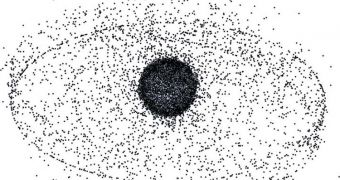Data from US military networks, and from independent German radar measurements show that the European Space Agency's (ESA) huge Envisat satellite passed incredibly close to the spent upper stage of a Chinese rocket last month. Telemetry data showed that the two spacecraft zipped past each other separated by a distance of just 160 feet (50 meters), which had space experts on the edge of their seats. The recent incident again underlines the deteriorating condition of our planet's orbit, which is becoming increasingly clogged with debris from all sorts of space missions, Space reports.
If the Chinese rocket had collided with the European satellite, the result would have been devastating. Envisat is one of the largest spacecraft in orbit, weighing in at around eight tons. The rocket stage weighs about 3.8 tons, so a combined mass of more than 11 tons would have been pulverized into fast-traveling shards. Such small pieces of metallic debris, which move with incredible speed, can cause a devastating chain reaction in orbit. If they impact other satellites, they have the ability to destroy them as well, creating even more shards and debris, and fueling the vicious circle. In order to avoid this scenario, European experts maneuvered their satellite using some of the propellant left onboard.
According to ESA official Heiner Klinkrad, who is the head of the Space Debris Office, in Darmstadt, Germany, a collision between the two objects would have spelled “mayhem.” He explains that the altitude at which the two are currently flying is already littered with debris as it is, and that further impacts could reduce the chances of any other spacecraft passing through and onward into space. At the same distance from the Earth's surface, a Russian Cosmos spacecraft collided with an American satellite early last year, producing a vast amount of debris. The other shards present in this particular orbit were generated by the Chinese anti-satellite test that was conducted in 2007.
“The future environment is expected to worsen without additional corrective measures,” NASA Johnson Space Center chief scientist for orbital debris Nicholas Johnson says. He adds that five spacecraft belonging to the American space agency had to undergo collision-avoidance maneuvers last year. These included the Tracking and Data Relay Satellite (TDRS-3), Cloudsat, the Earth Observing Mission 1, Aqua, and Landsat 7. What's more worrying, he adds, is that the International Space Station (ISS) and some shuttle missions also had to steer clear of incoming metallic fragments.
“A penetrating object hitting the ISS, and possibly causing a casualty onboard […] I think that would be the most dramatic case we could have,” Klinkrad shares, adding that medical evacuations from the ISS are incredibly difficult to even plan, let alone perform. Currently, there are two Americans, two Russians, and one Japanese aboard the orbital facility.

 14 DAY TRIAL //
14 DAY TRIAL //